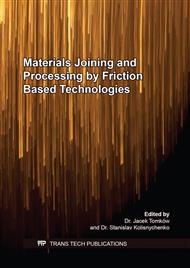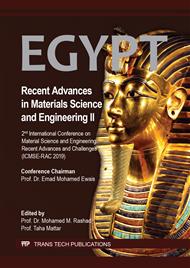[1]
Mishra, R. S., and Sidhar, H., 2016. Friction Stir Welding of 2XXX Aluminum Alloys including Al-Li Alloys. Butterworth-Heinemann.
DOI: 10.1016/b978-0-12-805368-3.00001-7
Google Scholar
[2]
Mishra, R. S., De, P. S. and Kumar, N., 2014. Friction stir welding and processing: Science and Engineering. Springer.
Google Scholar
[3]
Tozaki, Y., Uematsu, Y. and Tokaji, K., 2007a. Effect of processing parameters on static strength of dissimilar friction stir spot welds between different aluminium alloys. Fatigue and Fracture of Engineering Mater. Struct. 30, 143-148.
DOI: 10.1111/j.1460-2695.2006.01096.x
Google Scholar
[4]
Tozaki, Y, Uematsu, Y., and Tokaji, K., 2007b. Effect of tool geometry on microstructure and static strength in friction stir spot welded aluminium alloys. Inter. J. Mach. Tools and Manuf., 47, 2230-2236.
DOI: 10.1016/j.ijmachtools.2007.07.005
Google Scholar
[5]
Zhang, Z., Yang, X. Zhang, J. Zhou, G., Xu, X. and Zou. B., 2011. Effect of welding parameters on microstructure and mechanical properties of friction stir spot welded 5052 aluminum alloy. Mater. Design. 32, 4461-4470.
DOI: 10.1016/j.matdes.2011.03.058
Google Scholar
[6]
Yuan, W., Mishra, R. S., Webb, S., Chen, Y. L., Carlson, B. Herling, D. R., and Grant. G. J., 2011. Effect of tool design and process parameters on properties of Al alloy 6016 friction stir spot welds. J. Mater. Process. Technol. 211, 972-977.
DOI: 10.1016/j.jmatprotec.2010.12.014
Google Scholar
[7]
Lin, Y., Liu, J., Lin, B., Lin, C., and Tsai, H., 2012. Effects of process parameters on strength of Mg alloy AZ61 friction stir spot welds. Mater. Design. 35, 350-357.
DOI: 10.1016/j.matdes.2011.08.050
Google Scholar
[8]
Badarinarayan, H., Yang, Q., and Zhu, S., 2009. Effect of tool geometry on static strength of friction stir spot-welded aluminum alloy. Int. J. Mach. Tools and Manuf. 49, 142-148.
DOI: 10.1016/j.ijmachtools.2008.09.004
Google Scholar
[9]
Uematsu, Y., Tokaji, K., Tozaki, Y., Kurita, T., and Murata, S., 2008. Effect of re-filling probe hole on tensile failure and fatigue behaviour of friction stir spot welded joints in Al–Mg–Si alloy. Inter. J. Fatigue. 30, 1956-1966.
DOI: 10.1016/j.ijfatigue.2008.01.006
Google Scholar
[10]
Cao, J. Y., Wang, M., Kong, L., and Guo, L. J., 2016. Hook formation and mechanical properties of friction spot welding in alloy 6061-T6. J. Mate. Process. Technol. 230, 254-262.
DOI: 10.1016/j.jmatprotec.2015.11.026
Google Scholar
[11]
Reimann, M., Gartner, T., Suhuddin, U., Göbel, J., and dos Santos, J. F., 2016. Keyhole closure using friction spot welding in aluminum alloy 6061–T6. J. Mater. Process. Technol. 237, 12-18.
DOI: 10.1016/j.jmatprotec.2016.05.013
Google Scholar
[12]
Boldsaikhan, E., Fukada, S., Fujimoto, M., Kamimuki, K., Okada, H., Duncan, B., Bui, P., Yeshiambel, M., Brown, B. and Handyside. A. 2017, Refill Friction Stir Spot Joining for Aerospace Aluminum Alloys." In Friction Stir Welding and Processing IX. Springer, Cham, 237-246.
DOI: 10.1007/978-3-319-52383-5_23
Google Scholar
[13]
Zhou, L., Liu, D., Nakata, K., Tsumura, T., Fujii, H., Ikeuchi, K., Michishita, Y., Fujiya, Y. and Morimoto, M. 2012. New technique of self-refilling friction stir welding to repair keyhole." Sci. Technol. Weld. Join. 17, 649-655.
DOI: 10.1179/1362171812y.0000000058
Google Scholar
[14]
Sajed, M. 2016. Parametric study of two-stage refilled friction stir spot welding. J. Manuf. Processes. 24, 307-317.
DOI: 10.1016/j.jmapro.2016.09.011
Google Scholar
[15]
Chen, K., Liu, X. and Ni, J., 2017. Keyhole refilled friction stir spot welding of aluminum alloy to advanced high strength steel. J. Mater. Process. Technol. 249, 452-462.
DOI: 10.1016/j.jmatprotec.2017.06.039
Google Scholar



